Cyathus olla (Batsch) Pers. - Field Bird's Nest
Phylum: Basidiomycota - Class: Agaricomycetes - Order: Agaricales - Family: Agaricaceae
Distribution - Taxonomic History - Etymology - Culinary Notes - Identification - Reference Sources
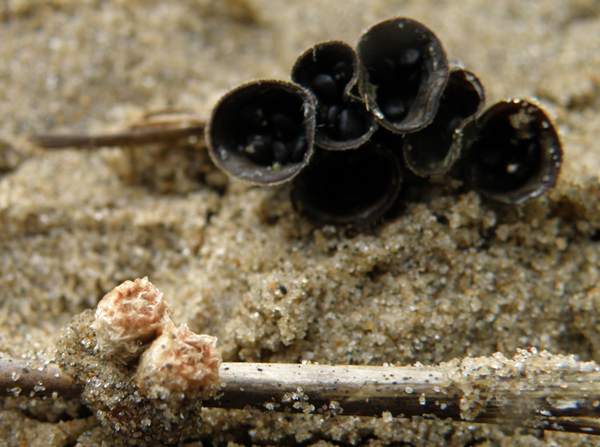
Cyathus olla is one of several species of bird's-nest fungi and is distinguished by its relatively large 'eggs' or peridioles as they are known in mycological circles. Although initially silvery, the eggs soon turn grey, giving the mature fruitbody a sombre appearance that is in stark contrast to its appearance when the 'lid' is on the nest. Although they occur on twigs and woodchip mulch, another good place to look for these tiny fungal fruitbodies is on dead marram grass stems on coastal sand dunes.
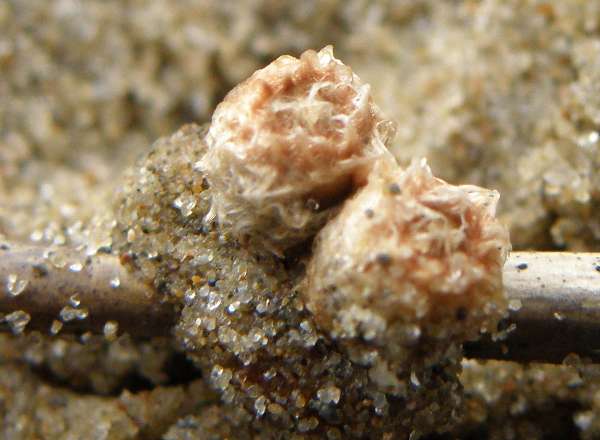
Distribution
Fairly common and widespread throughout Britain and Ireland, these little fungi occur in many other parts of the world including mainland Europe, Asia, Africa, North and South America and Australia. These and other kinds of bird's-nest fungus are not found often because of their small size even though they can be locally very common.
Taxonomic history
This gasteromycete fungus was described in 1783 by German mycologist August Johann Georg Karl Batsch (1761 - 1802), who gave it the binmomial scientific name Peziza olla. Christiaan Hendrik Persoon transferred this species to the genus Cyathus in 1801, thus establishing its currently-accepted scientific name Cyathus olla.
Synonyms of Cyathus olla include Peziza olla Batsch, Nidularia vernicosa Bull., Nidularia campanulata With., Cyathus olla f. olla (Batsch) Pers., Cyathus olla ß agrestis Pers., Cyathus vernicosus (Bull.) DC., Cyathus ollaris Gray, Cyathus vernicosus f. anglicus Lloyd, and Cyathus olla f. anglicus (Lloyd) H.J. Brodie.
Etymology
The generic name Cyathus comes from the Greek prefix kyath- meaning cup shaped (like a chalice). Less obvious is the meaning of the specific epithet olla, which means a squat, rounded pot or jar used to cook or store food. Cyathus olla is used to store eggs... well, sort of!
Identification guide
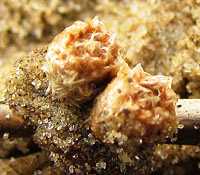 |
FruitbodyFunnel-shaped fruitbodies form initially as fluffy orange blobs on woody debris; they become darker with age, and the orange lid falls away to reveal the egg-like peridioles. Each peridium or 'nest' contains typical four or five silvery flattened 'eggs.' The outside of each peridium is covered with fine grey-brown hairs; the inner surface, in contrast, is smooth and hairless. DimensionsPeridia are 6 to 10mm across and up to 15mm tall, with noticeably flared rims. The individual peridioles are typically 3 to 3.5mm across. |
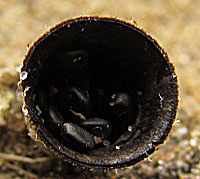 |
The silvery-white peridioles soon darken. Their attachment to the base of the nest-like cup is easily broken when raindrops hit them, and they are thrown out tiddlywinks style onto the ground, where they eventually split to release their spores. StemThe base of the cup tapers inwards to form a rudimentary stem. |
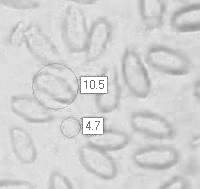 |
SporesEllipsoidal to ovoid, smooth, 10-14 x 5-8µm; inamyoid. Spore colourWhite. |
Odour/taste |
Not significant. |
Habitat & Ecological role |
Mainly found on fallen dead twigs, old rotting timber, manured soil, horse dung and decaying shrubby vegetation. In Britain this species can also be found on coastal dunes, where it is saprobic on dead marram grass stems. |
Season |
May to November in Britain and Ireland. |
Similar species |
Cyathus stercoreus is very similar (its rim is not so widely flared, however) but its spores are much larger even though the peridioles are much smaller; it is a dung-loving species (the specific epithet stercoreus means 'filth') but is also found on marram grass in coastal sand dunes. Several similar species occur throughout Europe. Cyathus striatus (with ribbed nest walls) and Crucibulum laeve are fairly common (but equally hard to spot) in Britain and Ireland as well as on mainland Europe and further afield. |
Culinary Notes
These fungi are reported to be inedible. My investigations to date have revealed no recipes for cooking these kinds of eggs, and the Field Bird's Nest is not an ingredient of any kind of bird's nest soup... as far as I know!
Reference Sources
Fascinated by Fungi, 2nd Edition, Pat O'Reilly 2016, reprinted by Coch-y-bonddu Books in 2022.
Dictionary of the Fungi; Paul M. Kirk, Paul F. Cannon, David W. Minter and J. A. Stalpers; CABI, 2008
Taxonomic history and synonym information on these pages is drawn from many sources but in particular from the British Mycological Society's GB Checklist of Fungi.
Fascinated by Fungi. Back by popular demand, Pat O'Reilly's best-selling 450-page hardback book is available now. The latest second edition was republished with a sparkling new cover design in September 2022 by Coch-y-Bonddu Books. Full details and copies are available from the publisher's online bookshop...

